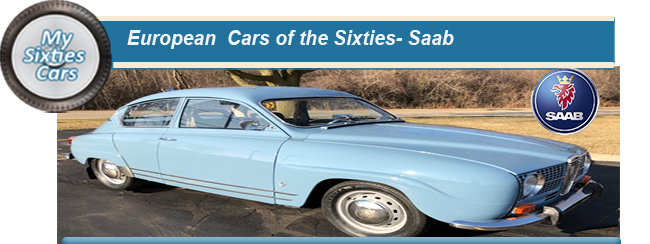
Saab (Svenska Aeroplan AB) was founded in in 1937 with the initial intention of building fighter aircraft for the Swedish Air Force.
The decision to establish an independent manufacturing unit for fighter aircraft came initially from the Swedish Government, concerned by the prevailing political situation in Europe.
Invited 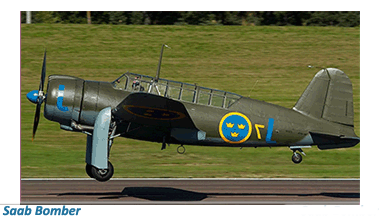 to form Svenska Aeroplan AB) to produce these aircraft on behalf of the Swedish Government were Svenska Aero AB (SAAB), established in 1921 to build commercial aeroplanes and VASJA a subsidiary of the Swedish Railway Workshops.
to form Svenska Aeroplan AB) to produce these aircraft on behalf of the Swedish Government were Svenska Aero AB (SAAB), established in 1921 to build commercial aeroplanes and VASJA a subsidiary of the Swedish Railway Workshops.
In 1938,Saab began to produce their first aircraft, mostly bombers, in the new plant situated in the city of Trollhattan, in the West of Sweden, Production got underway in 1937.
By the time hostilities ceased and World War II was over, more than three hundred Saab military aircraft had been built at Trollhattan, remaining in mothballs throughout the conflict.
The subject of much professional praise, Saab Aircraft has since become world famous and, apart from forming the backbone of the Swedish Air Force, are exported worldwide.
As was t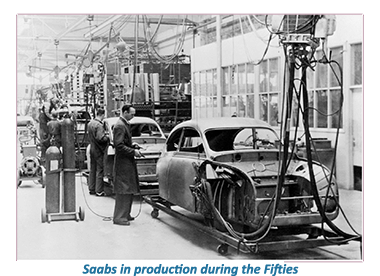 he case at the end of the WW2, most of the World’s aircraft manufacturers, or at least those whose plants had remained undamaged during the conflict, found themselves with massive production facilities that were almost entirely underemployed.
he case at the end of the WW2, most of the World’s aircraft manufacturers, or at least those whose plants had remained undamaged during the conflict, found themselves with massive production facilities that were almost entirely underemployed.
That was the case with Saab. Taking the lead from their UK counterparts in the UK, Bristol, the decision was made to move into producing cars, as the company wanted to continue to employ their highly trained and skilled personnel.
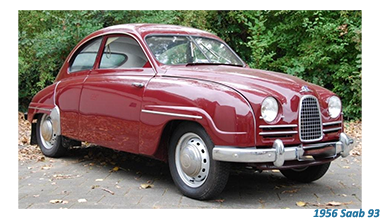 The first problem that Saab’s new car division had to confront was how to design a commercially attractive vehicle, as Sweden, if not all of Scandinavia, was not blessed with a lot of options as far as finding designers were concerned.
The first problem that Saab’s new car division had to confront was how to design a commercially attractive vehicle, as Sweden, if not all of Scandinavia, was not blessed with a lot of options as far as finding designers were concerned.
Refusing to be deterred, the company pulled in their two most talented aeronautical and aerodynamic specialists, Gunnar Ljungstrom and Sixten Sasanover.
Ljungstrom and Sasanover set to the task of designing the first Saab with gusto, employing all of the methods they had used in developing state of the art aircraft, including producing full-size clay and wooden models, which tested for their aerodynamic properties in the factory’s wind tunnel.
Each time a new Saab prototype was produced, it had been given the technical updates to iron out the flaws discovered and lessons learned from the previous trials.
![]()
By the time the first Saab was revealed in June of 1947, the prototypes had collectively covered more than 100,000 kilometres, ( 60,000 miles) some of them in the most testing of conditions. The first commercial Saab road car, the 92, was powered by a transversely mounted, front wheel drive twin-cylinder two-stroke engine. Response
 to the Saab 92 was generally positive, even when Saab dampened the enthusiasm of potential buyers when they announced that the first models would not be available for sale until December 1949.
Not to be deterred, a major Swedish car distributor Philipson’s Automobil AB placed an order for no less than 8,000 Saab 92s, and even paid a substantial advance on their order to help the new company’s cash flow.
As production got underway, Saab was soon to discover that establishing a car factory from scratch was no easy task, with the division hit by a seemingly endless stream of " teething problems."
This situation was not made any more comfortable with constant shortages of raw materials meaning that the new Saabs were coming off the production line painted a deep and unattractive shade of khaki green.
By the end of 1948, Saab approached Philipson’s Automobil to advise them that they were extremely doubtful of their capability to meet the promised delivery. Once again the owners of Philipson displayed great flexibility, virtually agreeing to wait what for whatever time it took for Saab to complete their order.
The reas
to the Saab 92 was generally positive, even when Saab dampened the enthusiasm of potential buyers when they announced that the first models would not be available for sale until December 1949.
Not to be deterred, a major Swedish car distributor Philipson’s Automobil AB placed an order for no less than 8,000 Saab 92s, and even paid a substantial advance on their order to help the new company’s cash flow.
As production got underway, Saab was soon to discover that establishing a car factory from scratch was no easy task, with the division hit by a seemingly endless stream of " teething problems."
This situation was not made any more comfortable with constant shortages of raw materials meaning that the new Saabs were coming off the production line painted a deep and unattractive shade of khaki green.
By the end of 1948, Saab approached Philipson’s Automobil to advise them that they were extremely doubtful of their capability to meet the promised delivery. Once again the owners of Philipson displayed great flexibility, virtually agreeing to wait what for whatever time it took for Saab to complete their order.
The reas on for their flexibility might well have been as a result of the extremely positive feedback from owners who already taken delivery of their new Saab 92 and had rapidly discovered their new cars were incredibly suitable for driving through the deep snow and the not quite developed roads that criss-crossed the Swedish countryside.
The Swedish car-buying public, few and far between in these days, were aware of the challenges and difficulties that driving would bring and were encouraged by Saab fitted the 92 with an almost entirely smooth floor pan which allowed the car to effortlessly glide over snow and slush instead of having to plough through it.
Slowly but steadily, Saab ironed out their production problems, and by the mid-Fifties, the Saab 92 was becoming a regular sight on Sweden’s roads- also painted in a broad variety of colours.
on for their flexibility might well have been as a result of the extremely positive feedback from owners who already taken delivery of their new Saab 92 and had rapidly discovered their new cars were incredibly suitable for driving through the deep snow and the not quite developed roads that criss-crossed the Swedish countryside.
The Swedish car-buying public, few and far between in these days, were aware of the challenges and difficulties that driving would bring and were encouraged by Saab fitted the 92 with an almost entirely smooth floor pan which allowed the car to effortlessly glide over snow and slush instead of having to plough through it.
Slowly but steadily, Saab ironed out their production problems, and by the mid-Fifties, the Saab 92 was becoming a regular sight on Sweden’s roads- also painted in a broad variety of colours.
![]()
Having put Saab on the map, the 92 was discontinued in summer of 1955 to be replaced by the 93.
The Saab 93 was merely an update of the 92, with the split windscreen that had so characterised the model replaced by a larger panoramic windscreen.
Apart from that significant update, to the casual onlooker, the two models were almost entirely identical in appearance.
Mechanic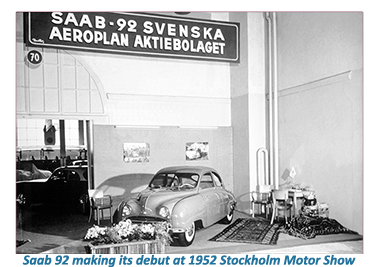 ally there was one notable difference, and that was that a three-cylinder two-stroke engine now powered the 93.
ally there was one notable difference, and that was that a three-cylinder two-stroke engine now powered the 93.
In regular two year intervals, Saab released updates on their basic saloon, eventually bringing the model to its maximum level with the 96, released in 1960, which would remain in production for the next two decades.
With sales of the 93 continuing to rise, feeling increasingly confident in expanding their market, Saab decided to make an entry into the sports coupe sector.
In their typically pedantic fashion, Saab invested a moderate amount of money and an unreasonable length of time in developing the Sonett II launched in 1965 after being under development for ten years.
After all that the Sonett II was far from being a commercial success and the subject of considerable criticism for its awkward lines and cumbersome design.
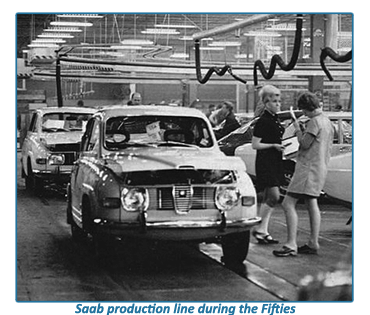 Just five years in production, Saab pulled the switch on the Sonett, eventually realising that the world of sports coupes was not for them.
Just five years in production, Saab pulled the switch on the Sonett, eventually realising that the world of sports coupes was not for them.
In the meantime, Saab introduced its first entirely new model since the 92 when it released the Saab 99 in the fall of 1967. The 99 fell into the category of a luxury sedan and was very well received by the motoring press and public alike, remaining in production and selling more than half a million models over the next twelve years.
With the car division eventually holding its own, Saab began to diversify their interests into some other fields, among them defence systems and aeronautics.
It soon became apparent to the board at Saab that their car manufacturing division at Saab was something of a poor relation.
This shaky situatin was confirmed when the car division entered into a series of unsuccessful amalgamations and mergers that gradually caused the company’s value to dilute to such an extent, that Saab Motors ceased production in 2011.






